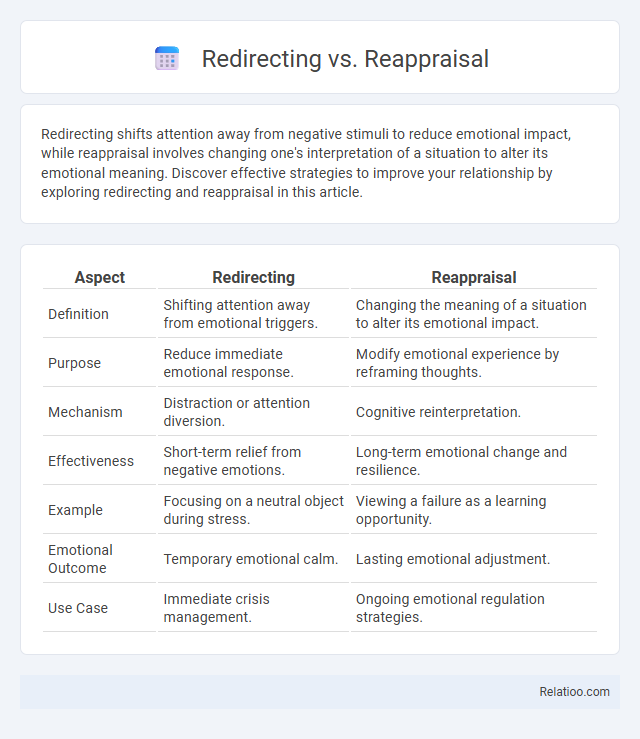Redirecting shifts attention away from negative stimuli to reduce emotional impact, while reappraisal involves changing one's interpretation of a situation to alter its emotional meaning. Discover effective strategies to improve your relationship by exploring redirecting and reappraisal in this article.
Table of Comparison
| Aspect | Redirecting | Reappraisal |
|---|---|---|
| Definition | Shifting attention away from emotional triggers. | Changing the meaning of a situation to alter its emotional impact. |
| Purpose | Reduce immediate emotional response. | Modify emotional experience by reframing thoughts. |
| Mechanism | Distraction or attention diversion. | Cognitive reinterpretation. |
| Effectiveness | Short-term relief from negative emotions. | Long-term emotional change and resilience. |
| Example | Focusing on a neutral object during stress. | Viewing a failure as a learning opportunity. |
| Emotional Outcome | Temporary emotional calm. | Lasting emotional adjustment. |
| Use Case | Immediate crisis management. | Ongoing emotional regulation strategies. |
Understanding Redirecting and Reappraisal
Redirecting involves shifting attention from a negative stimulus to a neutral or positive one, effectively changing the focus without altering the initial emotional response. Reappraisal, however, modifies the interpretation of the stimulus itself, reshaping the emotional experience by reframing the meaning. Understanding redirecting and reappraisal highlights how redirection manages attention, while reappraisal transforms cognitive evaluation, both crucial strategies in emotion regulation research.
Key Differences Between Redirecting and Reappraisal
Redirecting involves changing the focus of attention or behavior to a different activity or thought, often used to manage immediate reactions or behaviors. Reappraisal is a cognitive strategy that modifies the interpretation or meaning of an emotional stimulus to alter its emotional impact, primarily targeting emotional regulation. The key difference lies in redirecting shifting external focus to influence behavior, whereas reappraisal internally changes the perception of a situation to regulate emotions.
The Psychology Behind Redirecting
Redirecting in psychology involves consciously shifting attention or behavior away from a negative or unproductive thought pattern to promote emotional regulation and cognitive control. Unlike reappraisal, which reshapes the interpretation of an experience to alter its emotional impact, redirecting emphasizes immediate distraction or engagement in alternative actions to manage stress or impulsivity. Neuroscientific studies link effective redirecting to increased prefrontal cortex activity, highlighting its role in executive function and adaptive coping mechanisms.
The Science of Reappraisal
Reappraisal, a core technique in cognitive behavioral therapy, involves changing your interpretation of a situation to alter its emotional impact, supported by neuroscience studies showing reduced amygdala activity during successful reappraisal. Unlike redirecting, which shifts your attention away from a stimulus, reappraisal directly modifies your emotional response by reframing thoughts. Research highlights that consistent use of reappraisal improves emotional regulation and resilience, making it a powerful tool for managing stress and anxiety effectively.
Benefits of Redirecting in Emotional Regulation
Redirecting in emotional regulation offers the benefit of swiftly guiding your focus away from distressing stimuli toward more positive or neutral activities, effectively reducing emotional intensity without suppressing feelings. This method promotes adaptability by encouraging proactive shifts in attention, enhancing emotional resilience and preventing escalation of negative emotions. You gain increased control over your emotional responses, fostering improved mental clarity and better decision-making during challenging situations.
Advantages of Reappraisal for Mental Health
Reappraisal, a cognitive emotion regulation strategy, transforms negative thoughts by altering their meaning, leading to reduced stress and improved emotional well-being. Unlike redirecting, which shifts attention, or suppression that may cause emotional buildup, reappraisal fosters resilience by promoting healthier psychological responses and long-term mental health benefits. Research highlights that habitual use of reappraisal correlates with lower anxiety, depression rates, and enhanced overall cognitive functioning.
When to Use Redirecting vs Reappraisal
Redirecting is most effective when immediate behavior change is needed, especially in situations involving children or impulsive actions, allowing you to steer attention away from undesired behavior swiftly. Reappraisal works best for managing emotions by reframing your interpretation of a situation to reduce its negative impact, ideal for long-term emotional regulation and cognitive restructuring. Your choice depends on whether you aim to alter external behavior quickly (redirecting) or transform internal emotional responses over time (reappraisal).
Common Challenges and Misconceptions
Redirecting, reappraisal, and redirection often face the common challenge of being misunderstood as interchangeable techniques, yet each serves a distinct purpose in cognitive and behavioral management. Misconceptions arise when redirecting is confused with avoidance rather than a strategic shift of focus, while reappraisal is frequently underestimated for its role in changing emotional responses through reframing thoughts. Your effective use of these strategies depends on recognizing that redirecting adjusts attention, reappraisal modifies interpretation, and redirection involves guiding behavior, all requiring clear differentiation to overcome implementation challenges.
Practical Strategies for Effective Implementation
Redirecting involves changing the focus of attention to an alternative activity or thought, effectively interrupting negative patterns, while reappraisal entails cognitively reframing a situation to alter its emotional impact, promoting adaptive emotional responses. Practical implementation of redirecting can include distraction techniques such as engaging in physical tasks or mindfulness exercises, whereas reappraisal requires deliberate practice of perspective-taking and reinterpretation skills through guided reflection or cognitive-behavioral interventions. Combining both strategies in therapy or daily routines enhances emotional regulation by providing immediate coping tools (redirecting) alongside long-term cognitive restructuring (reappraisal).
Choosing the Right Technique for Your Situation
Redirecting, reappraisal, and refocusing each serve distinct roles in managing emotions and behaviors, with redirecting shifting attention away from triggers, reappraisal changing the interpretation of an event, and refocusing enhancing concentration on alternative tasks. You should evaluate the context and emotional intensity to select the right technique, as redirecting suits immediate distractions, reappraisal benefits long-term cognitive shifts, and refocusing supports sustained mental effort. Understanding these differences ensures optimal emotional regulation tailored to your specific situation.

Infographic: Redirecting vs Reappraisal
 relatioo.com
relatioo.com